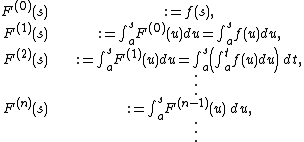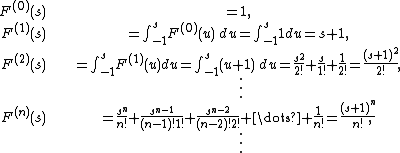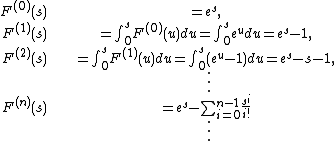- Generalisations - The concept of a sequence of iterated integrals Example 1 Example 2 Example 3 Theorem
- References
In mathematics, the Hermite–Hadamard inequality, named after Charles Hermite and Jacques Hadamard and sometimes also called Hadamard's inequality, states that if a function ƒ : [a, b] → R is convex, then the following chain of inequalities hold:
Generalisations - The concept of a sequence of iterated integrals
Suppose that −∞ < a < b < ∞, and let f:[a, b] → ℝ be an integrable real function.
Under the above conditions the following sequence of functions is called the sequence of iterated integrals of f,where a ≤ s ≤ b.:
Example 1
Let [a, b] = [0, 1] and f(s) ≡ 1. Then the sequence of iterated integrals of 1 is defined on [0, 1], and
Example 2
Let [a,b] = [−1,1] and f(s) ≡ 1. Then the sequence of iterated integrals of 1 is defined on [−1, 1], and
Example 3
Let [a, b] = [0, 1] and f(s) = es. Then the sequence of iterated integrals of f is defined on [0, 1], and
Theorem
Suppose that −∞ < a < b < ∞, and let f:[a,b]→R be a convex function, a < xi < b, i = 1, ..., n, such that xi ≠ xj, if i ≠ j. Then the following holds:
where
In the concave case ≤ is changed to ≥.
Remark 1. If f is convex in the strict sense then ≤ is changed to < and equality holds iff f is linear function.
Remark 2. The inequality is sharp in the following limit sense: let and
and 
Then the limit of the left side exists and
References
- Jacques Hadamard, "Étude sur les propriétés des fonctions entières et en particulier d'une fonction considérée par Riemann", Journal de Mathématiques Pures et Appliquées, volume 58, 1893, pages 171–215.
- Zoltán Retkes, "An extension of the Hermite–Hadamard Inequality", Acta Sci. Math. (Szeged), 74 (2008), pages 95–106.
- Mihály Bessenyei, "The Hermite–Hadamard Inequality on Simplices", American Mathematical Monthly, volume 115, April 2008, pages 339–345.
- Flavia-Corina Mitroi, Eleutherius Symeonidis, "The converse of the Hermite-Hadamard inequality on simplices", Expo. Math. 30 (2012), pp. 389–396. DOI:10.1016/j.exmath.2012.08.011; {{ISSN|0723-0869}}
- First American Title Insurance Corporation
- First American Trust Company
- First Among Sequels
- First and 10
- First and last and always
- First And Last Waltz
- First and Principal Naval Aide-de-Camp
- First and Principal Naval Aide de Camp
- First & André
- First and Second Battles of El Teb
- First and Second Books of Samuel
- First and third trinity boat club
- First angle projection
- First-angle projection
- First Anglo Afghan war
- First Anglo-Boer War
- First Anglo-Chinese War
- First Anglo-Powhatan War
- First Anniversary (episode)
- First anniversary of the September 11, 2001
- First Annual Convention of the IWW
- First Annual Report
- First Ao-Gui War
- First apocalypse of james
- First Apology







